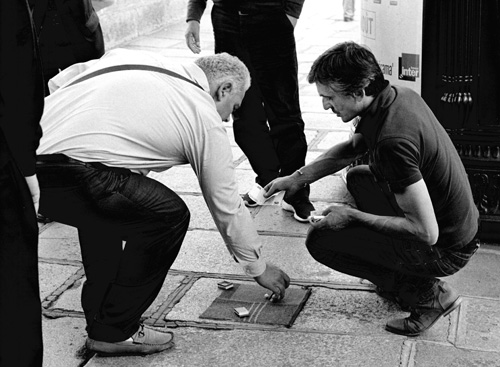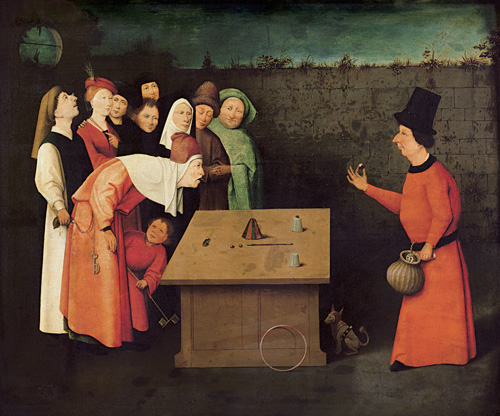
Your complimentary articles
You’ve read one of your four complimentary articles for this month.
You can read four articles free per month. To have complete access to the thousands of philosophy articles on this site, please
Street Philosopher
Paltering In Paris
Seán Moran watches a street con to find where deceiving is not lying.
The ‘Find the Lady’ scam entices passers-by on the street into giving away substantial amounts of cash to petty crooks. Sometimes three playing cards are involved, one of which is the queen of hearts (‘the Lady’); or, as my photograph taken on the banks of the River Seine in Paris shows, three matchbox trays can be used, one covering a pea-sized ball. What all variants of this scam do is to capitalise on certain aspects of human nature. In particular, they manipulate both our epistemic and ethical susceptibilities so that the scamsters always win and the punters always lose.
‘Find the Lady’ (a.k.a. ‘Three Card Monte’ or ‘The Shell Game’) is a notorious piece of deception, even though nobody tells any lies. It involves not lying but paltering. To palter is to lead or allow another person wrongly to believe that something is the case without actually lying to them. It’s not that the scamsters have any ethical reservations about telling lies, its more a case of paltering here being especially effective because the participants themselves have also become morally compromised.
So how does it work, and why is it philosophically interesting?

Cherchez La Femme en Paris
Photo © Seán Moran
This Is Not A Lie
First let’s spend a moment considering outright lying. To lie entails (i) The intention to deceive; (ii) The uttering of an untrue statement; and (iii) The real potential to be believed by the listener. So if you are genuinely mistaken about what you say, by failing the first criterion your false assertion is not a lie. And if you tell a joke about, say, a horse going into a bar, no-one will take you literally, so again you avoid being guilty of lying, because of the final criterion. Medieval philosopher and theologian Thomas Aquinas would call your equine story a ‘jocose lie’, and conclude that it isn’t a serious transgression. However, the three criteria also let off the hook some people who do intend to deceive and actually succeed in doing so, since if they didn’t utter a falsehood, strictly speaking they have not lied, judging by the second criterion. Yet we still feel that they have done something wrong. And so they have: not lying, but paltering.
Most of us palter from time to time in a relatively harmless way. For example, we might allow our guests mistakenly to believe that we baked the shop-bought cake we’re offering them. The technical detail that we never made such a claim out-loud does not totally free us from blame, for by omitting to correct their false belief we have wilfully failed to respect their philosophical mission to gather true propositions about the world. But in the great scheme of things, our bakery-based moral transgression is usually seen as being quite minor. Even lies that clearly meet all three of our criteria are sometimes regarded as fairly innocuous too, as long as they are well-intentioned. For instance, to avoid hurting others’ feelings, we might reassure them that the hideous garment they’re wearing looks “fine”. Aquinas would be reasonably happy with this white lie too. He feels that lying is diminished in gravity when a greater good is intended. By contrast, Eighteenth Century Prussian philosopher Immanuel Kant argues that truth-telling is an exceptionless duty. Kant never married.
Then there are lies and palters with malicious intent. The paltering in my photograph of the ‘Cherchez La Femme’ on the streets of Paris is of the malevolent type. Its only purpose is to deprive the unwary of their money, with nothing gained by them in return. The well-groomed bystander who is apparently winning by turning over the correct matchbox is actually a confederate of the crouching conman. Others in the crowd are accomplices or ‘shills’, too. And nearby there are two look-outs to warn of the impending arrival of the gendarmes.
Scammed Epistemologically
Once the team is in place the manipulation of our epistemic and ethical weaknesses can begin.
In the epistemic domain – relating to questions of knowledge and its justification – the scam involves using our powers of induction against us. After watching a few iterations of the game, we may reach the erroneous conclusion that here is an opportunity for us to make some easy money. But contrary to appearances, there is no chance of winning, and there are many ways to lose.
This is a beautiful, if expensive, example of a phenomenon first analysed by the Eighteenth Century Scottish philosopher, David Hume – the problem of induction. Although he never uses the word ‘induction’, Hume explains how we derive general principles of behaviour by repeatedly observing something happening, which is what induction is. Hume thought that having never seen a game of billiards before, Adam, the first man according to the Old Testament, would not be able to predict the effect of one billiard ball hitting another. Only after observing a number of collisions could he derive the general principles by induction, and even then his conclusions might be wrong. But, Hume argues, all that we can establish by our observations are ‘associations of ideas’ – one state is seen to follow another – not cast-iron principles. So how do we justify our principles? No matter how many times we see the sun rising each morning, we have no absolute guarantee that it will rise tomorrow. In his Treatise of Human Nature (1740), Hume insists that there are no solid grounds for believing that “instances of which we have had no experience, must resemble those of which we have had experience, and that the course of nature continues always uniformly the same.” And the connections we’ve perceived can fail.
When roguery and deceit enter the scenario, the possibilities for induction failing to provide us with reliable knowledge increase significantly. In his naivety, Adam would surely be an easy target for pool hustlers (he and Eve easily fell for the serpent’s ‘forbidden fruit’ scam, after all). Pool, a relation of billiards, sometimes involves excellent players faking clumsiness in order to win money from unsuspecting average players. The moderately-skilled mark plays a few friendly games with the hustler, all of which the mark wins. When a bet on the game is proposed, the mark willingly wagers a substantial amount, because he has formed the conclusion by induction that his own pool skills are superior. Now the hustler miraculously improves his game and wins the money. If he is particularly cunning, he will make his victory appear to be a lucky accident, and thereby tempt the mark to try winning his money back. Further losses ensue, until the mark has an empty wallet.
The Paris punters looking for balls or cards similarly reach false conclusions about the likelihood of their winning based on inductive evidence. They observe some players (who are in fact shills) apparently winning money. And – significantly – they see others losing, when they, with their superior observational skills, would have identified the correct matchbox. They might even accept the dealer’s offer of a practice game, using the dealer’s money, which they then go on to win. This leads them to the counterfactual conclusion: ‘Had I bet with my own cash, I would have won €50’. The crowd congratulates them on their win and recommends proper participation. All of this inductive and social pressure emboldens the mark to place a wager. They feel sure that they will win. But this confidence is misplaced, based on bad epistemology, an induction to a false conclusion founded on biased evidence. They don’t win because they can’t win: the only option is to lose.
The first route to loss is similar to the method by which the victim of pool hustling is beaten once a wager is made. The dealer’s dexterity suddenly goes into overdrive. Nobody could follow his manipulations of the matchboxes, and even if they could, the dealer can transfer the ball from one box to another without anyone realising. Note how he holds banknotes in his hands, conveniently obscuring his sleight-of-hand when he shuffles the boxes. If by a fluke the mark correctly identifies the matchbox covering the ball, somebody from the crowd will place a higher bet and win the prize. (This winner, of course, is a shill.) Or the mark will be given his winnings of €100 in counterfeit notes while the dealer keeps the genuine €50 originally staked. If all else fails, someone will shout “Police!” and everyone scatters. And if the gendarmes really do arrive, the mark would be unwise to admit any involvement in illegal street gambling.

The Conjurer Hieronymous Bosch 1502
The Wagers of Greed
This scam has been going on for centuries so it’s surprising that it still claims victims. A 1502 painting by Hieronymous Bosch, The Conjurer, recognisably depicts a ‘Find the Lady’ scamster in action, bamboozling his late medieval audience. It even illustrates a further way of losing money: another crook is deftly stealing a man’s purse while his attention is distracted by the game. This technique is still common today, so even non-participating bystanders can lose their money.
The victims who take an active role by placing bets are themselves at least partly to blame when they lose. As well as an epistemic over-confidence in their powers of observation and induction, they also demonstrate an ethical failure. The mark is not as naïve as we might initially think. A genuine innocent would not want to take money from an outwardly incompetent dealer. Rather, in all scams of this type, the mark is trapped by his own dishonourable motivation to benefit from someone else’s perceived weakness – the pool hustler’s apparent lack of ability; the matchbox manipulator’s ostensible incompetence. It is an attempt to outwit a seemingly clumsy operator by superior skills. But, in a perhaps deserved reversal, the tables are turned and the intended victim exploits the mark. Nobody emerges from the transaction with any great honour. We may feel sorry only for the audience members who are pickpocketed. They have acted neither from epistemic arrogance nor from greed, but have still lost out.
It would be tempting to finish our discussion of paltering scams with the general rule that if something looks too good to be true it probably is. But that principle was established by induction, and induction, as we saw, is a dangerous game.
© Dr Seán Moran 2016
Seán Moran is a philosopher in Waterford Institute of Technology, Ireland. In his spare time he uses vintage cameras to photograph life on the streets.









